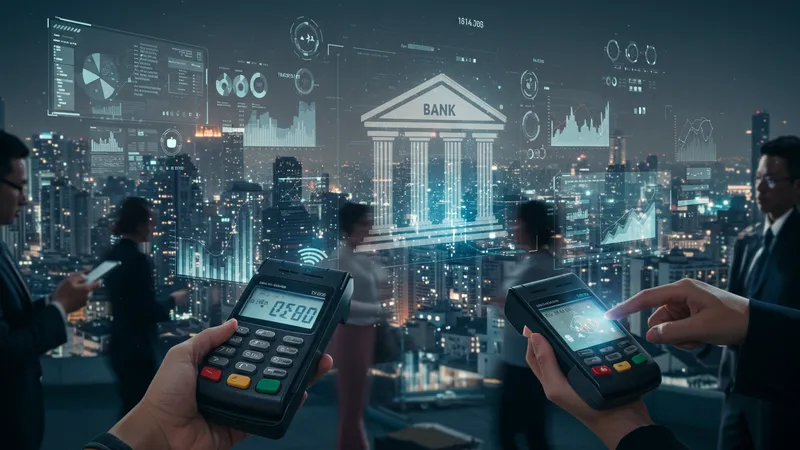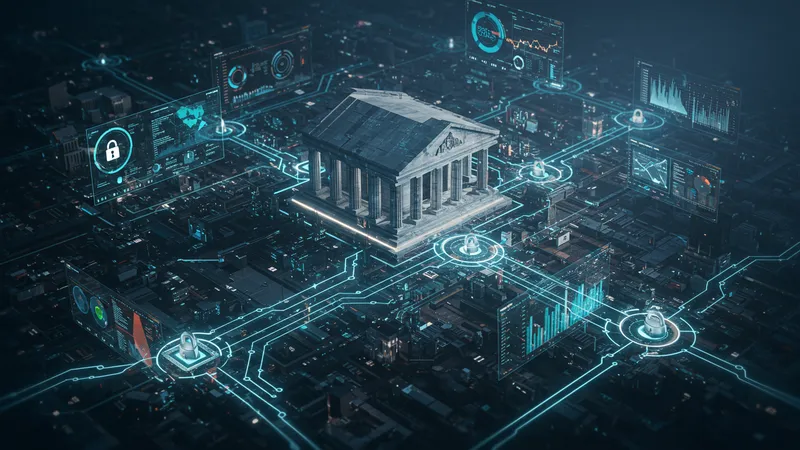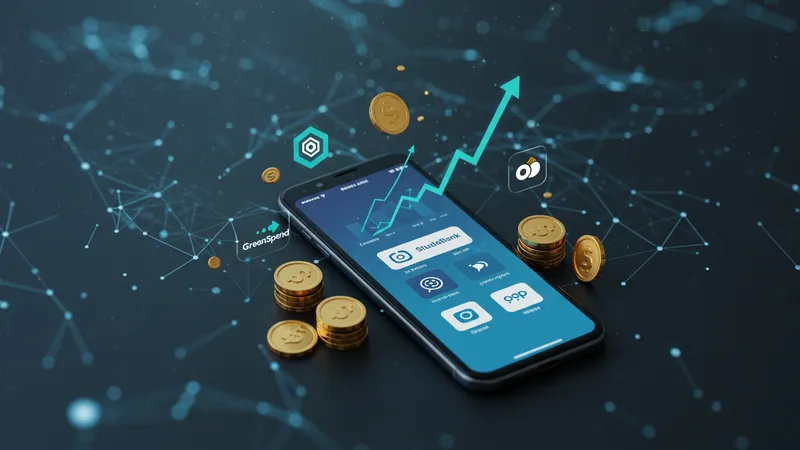Did you know that the average person makes more contactless payments in a month than traditional cash transactions? It’s true! The way we bank is evolving faster than ever, and this is just the tip of the iceberg.
As digital landscapes expand, understanding modern banking services is crucial for everyone. Why? Because the future of finance could make or break our financial stability. But how does one navigate this rapidly changing world?

The transformation in banking isn’t just about technology—it's about revolutionizing how we think about money. Take the emergence of personalized financial advice through AI—an area once reserved for the rich. With software like Robo-Advisors, tailored money management is available at your fingertips, democratizing finance. But that’s not even the wildest part…
Banks are now delving into realms like augmented reality to engage customers. Imagine virtual bank branches and financial planning from your living room. These innovations are not merely about convenience; they are reshaping our fundamental interactions with money. Yet, there's a revolution happening beneath the surface…
What happens next shocked even the experts and could redefine banking forever. Will you be ready to embrace these changes? Keep reading to uncover the hidden future of finance...
For decades, banking was a closed circuit, a fortress with impenetrable walls. But recently, the fortress has opened its gates to a new player: APIs (Application Programming Interfaces). These digital bridges allow third-party developers access to a bank’s infrastructure to create innovative solutions that redefine customer experience. Imagine a world where your accounting software automatically retrieves bank statement data without you lifting a finger. The convenience is shaping new possibilities for consumers and businesses alike.

But how safe is this open-door policy? Banks employ a rigorous vetting process for fidelity and reliability of these APIs. Nevertheless, potential risks linger. Consider unauthorized access and data breaches, which can compromise sensitive financial information. Despite these fears, banks have integrated robust security measures, redefining safety standards in financial technology. And yet, the ripple effect of this technological shift is still unfolding...
This embrace of open banking fosters innovation, propelling fintech startups to the forefront of the industry. Such collaborations can lead to superior financial products, customized to user preferences, increasing customer satisfaction and loyalty. Moreover, it levels the playing field, allowing smaller banks to compete with industry giants. But there’s one more twist...
APIs are not just about efficiency—they’re transforming your role in financial decision-making. With the power of personalized insights at your fingertips, you can optimize your financial health like never before. This ongoing transformation invites us to question traditional banking roles as we know them. What you read next might change how you see this forever.
Cryptocurrency isn’t merely synonymous with Bitcoins anymore. Today, there are over 10,000 cryptocurrencies, each with its niche and utility. While Bitcoin remains the poster child, Ethereum, Ripple, and Dogecoin have established their presence. The rise of decentralized finance (DeFi) is particularly noteworthy as it promises a future free from centralized authority interference. Interest in crypto has surged, with adoption rates doubling within the past year alone.

Surprisingly, major banks, once skeptical of digital currencies, are now investing in blockchain technology. Consider JPMorgan Chase, which developed its own cryptocurrency, JPM Coin, used for instant payments between institutional accounts. This shift signifies a new era in financial services where traditional banking meets digital innovation. Much like the evolution of the internet, crypto is carving out a new frontier.
Yet, the volatility of cryptocurrency markets cannot be ignored. The dramatic value fluctuations have discouraged risk-averse individuals. However, as regulatory dialogues intensify globally, the stability of these digital currencies is improving. These regulations are slowly ushering in mainstream acceptance, reshaping how we perceive digital transactions. Still, another mystery persists...
Crypto’s broader implications extend beyond finance—it’s about decentralizing power and fostering individual sovereignty. As awareness grows, more individuals are using it for everyday transactions, from buying groceries to investing in art. This adoption trend indicates a significant cultural shift, one that requires us to rethink our definitions of money and value. The evolution is far from over, and upcoming innovations will likely surprise you.
Neobanks are redefining banking by offering a digital-first, user-centric experience. Think of them as banks with no physical branches but rather, all-day, all-week services right on your smartphone. These financial disruptors are attractive to a generation seeking transparency, accessibility, and superior user experiences. With no overhead costs of physical branches, they pass on savings to customers through higher interest rates and lower fees.

This digital-centric approach is shaking up the traditional banking industry, forcing incumbent banks to innovate swiftly or risk losing market share. Notably, neobanks often target niche markets: think of StudentBank, catering exclusively to college needs, or GreenSpend, focusing on sustainable investments. Their agility and adaptability are key to their growing success.
However, the question of stability lingers. Can these tech-driven banks withstand economic downturns or financial crises? Despite lacking the historical depth of traditional banks, many neobanks have established partnerships with established banking institutions to ensure a secure financial footing. This blending of innovation with tradition might be the formula for future resilience.
The implications are profound: neobanks are not only about convenience but also about inclusivity, reaching demographics previously underserved by traditional banking due to constraints such as income levels or geographical isolation. This shift is democratizing access to financial tools, heralding a new era where banking is no longer a privilege but a right. But this is just the beginning...
In an effort to revolutionize customer interactions, some banks are experimenting with augmented reality (AR). Imagine hosting financial consultations or navigating complex mortgage processes from the comfort of your home, visualized through AR glasses. While this may sound futuristic, banks like Citi and BNP Paribas are already investing in research to make this a reality, driven by the promise of effortless banking experiences.

What makes AR in banking so compelling is its potential to simplify and enhance the customer experience. Picture viewing a detailed 3D breakdown of your spending habits projected onto your living room wall, offering insights at a glance. This level of engagement could transform financial planning from a chore into an interactive experience.
Yet, the implementation of AR technologies in banking raises questions about privacy and data security. As virtual and physical realities merge, stringent protocols must ensure sensitive information is protected, preventing unauthorized access. The balancing act between innovation and security will determine the success of this technological leap.
As banks refine these AR capabilities, the broader impact is undeniable. It signifies a pivotal shift in how we approach financial interactions, fostering convenience and deeper engagement. The journey towards fully integrated AR in everyday banking is accelerating, promising a future where banking becomes an intuitive part of our lives. But are there more surprises down the line?
Originally seen as a luxury, contactless payments have swiftly transformed into a necessity. Their growth has been nothing short of explosive, marking an 82% increase in usage over the past year. These touchless transactions, enabled by NFC technology, have become an everyday convenience preferred by millions worldwide for their speed and hygiene benefits.

Contactless payments are not just about convenience; they’ve reshaped the economic fabric. Retailers have noted a significant decrease in cash handling costs and an increase in transaction volumes, boosting the bottom line. Moreover, banks enjoy reduced fraud risks thanks to more secure transactions. It seems like a win-win scenario, but there's more beneath the surface...
The environmental impact of contactless payments is often overlooked. As digital transactions rise, the need to produce and dispose of paper receipts declines, contributing to a positive environmental impact. However, this shift underscores the importance of sustainable solutions to manage the e-waste generated by expired cards and devices.
At a cultural level, the shift towards contactless payments signals a departure from traditional currency, nudging us towards a more digital-dependent society. This change prompts us to rethink daily transactions and encourages even those wary of technology to embrace a digital-first approach. But what are the unexpected challenges lurking ahead?
If you’ve ever been strung along by the allure of bank loyalty programs, you’re not alone. These programs have changed the landscape by transforming how consumers interact with banks, offering rewards like cashback, travel discounts, and more. However, these attractive schemes often harbor hidden complexities and terms that customers overlook.

The mechanics behind these programs are strategic. By offering valuable rewards, banks encourage customers to consolidate their financial activities within their ecosystem, fostering long-term loyalty and increased data collection opportunities. However, with intricate conditions linked to each reward, not all customers reap the desired benefits. There's a fine print that often surprises even the most diligent customers.
These programs inspire an important conversation about value and choice. Are customers really benefiting, or are they just locked into a system that, ultimately, benefits the banks? It raises the question of how these schemes influence our financial decisions and whether they encourage spending beyond our means.
Loyalty programs are not just marketing tools; they are data mines, collecting insights into consumer behaviors. Understanding these dynamics can shift how we engage with such programs, encouraging more informed decisions. As new loyalty features continue to evolve, what will they reveal about us? The unexpected truths lie ahead.
Explore any bustling street market, and you’ll see that cash isn’t disappearing just yet. Despite the digital economy’s rapid growth, cash remains a popular payment choice, especially in cultures with a traditional affinity for physical currency. But why does it endure where digital seems to dominate?

One crucial factor is accessibility. Cash is universally accepted, requiring no special technology or preparation, making it a go-to choice during tech downtimes or in areas with limited digital infrastructure. Moreover, cash transactions guarantee privacy in a way digital transactions do not, a consideration that still holds weight for many.
However, carrying and storing physical currency can pose security risks and management challenges. With digital options offering enticing ease and security, the battle between cash and digital continues to play out across global markets, each side pushing forward with its distinct advantages and disadvantages.
Despite cash’s continued relevance, its grip is slipping. As digital literacy and trust increase, and privacy concerns are addressed, digital is set to win over more users. The era of cash as king might be waning, but how will the final chapter unfold? The signs ahead are intriguing...
Artificial Intelligence (AI) is quietly revolutionizing banking as we know it. From lending to investment advice, AI-powered tools are redefining efficiency and personalization. Consider robo-advisors that tailor investment strategies based on individual preferences and risk profiles, making sophisticated financial management accessible for the masses.

Yet, AI’s role in banking transcends mere convenience. By processing vast amounts of data swiftly, AI can predict market trends and identify fraudulent activities faster than human capabilities allow, enhancing security and reducing operational costs. This technological leap offers banks an edge, capturing the competitive advantage crucial in this digital age.
The integration of AI brings unforeseen ethical and practical challenges. Questions surrounding data privacy, algorithm biases, and the potential for job displacement arise as AI continues to influence the industry's trajectory. Navigating these complexities will shape the future of ethical banking.
As AI systems grow cleverer, they could potentially redefine our interactions with money, moving from simply transactional to deeply personalized experiences. As banks refine these technologies, they may open doors to creative solutions we hadn’t yet dreamed of. What will be the next AI-driven innovation to surprise us?
While Bitcoin has stolen the spotlight, blockchain technology’s potential stretches far beyond just cryptocurrencies. Its fundamental attribute—secure, transparent, and immutable records—could transform everything from supply chain management to real estate. Industries are exploring these capabilities, seeking efficiency and trust in operations.

Banking stands to benefit enormously. Imagine transactions settled in real time, removing intermediaries, reducing costs, and increasing speed. Major banks are investigating blockchain’s potential to streamline processes such as international transfers and smart contracts, which could eventually eliminate paperwork and manual verification for many services.
But the road to blockchain integration is not without its obstacles. Regulatory uncertainty and technological challenges make widespread adoption slow and complex. Furthermore, scalability remains a key concern as blockchain protocols evolve to accommodate larger volumes of global transactions.
Despite these challenges, blockchain offers an exciting opportunity to reimagine banking and trust systems. As institutions inch closer to broader adoption, it’s only a matter of time before we see transformational shifts. What unforeseen changes await in blockchain’s wake?
Modern banking technology is opening doors once locked to the world’s unbanked population. An estimated 1.7 billion adults remain without a bank account, but initiatives focusing on mobile banking and microfinancing are changing lives. Imagine managing finances through a smartphone app in regions without traditional banking infrastructure.

The impact is profound, with platforms like M-Pesa in Kenya revolutionizing access to financial services, allowing users to save, borrow, and transfer money directly from their phones. This shift is proving vital for economic empowerment, enabling individuals to build credit and invest in their futures with previously unimaginable ease.
However, despite these advances, challenges such as digital literacy and access to technology remain critical obstacles. For technology to realize its full potential in fostering financial inclusion, targeted educational efforts and partnerships must address these gaps, ensuring equitable access across different populations.
As innovations continue, financial technology has the power to reshape economies and societies, promoting sustainability and growth. The road to full financial inclusion is long, but the ongoing technological advancements signal a promising future. Could technology erase the banking divide entirely?
The intersection of innovation and finance has created limitless possibilities for the future of banking. As we navigate this digital transformation, the race for technological superiority continues, with banks vying to deliver the most state-of-the-art experiences. From biometric security to instant cross-border payments, what can we foresee next?

Digital initiatives are reaching new heights with quantum computing on the horizon, promising computation power to address currently unsolvable problems, reshaping how banks manage risk and detect fraud. Alongside, wearable banking technology heralds a new era where consumers can manage financial affairs with a flick of the wrist.
The sharpening of these technologies challenges the traditional roles of financial institutions and invites dialogue on ethics, security, and the human touch in banking. As consumers demand increasingly seamless experiences, banks must adapt swiftly to stay relevant in a constantly evolving market.
The transformation brings us to an age where the only constant is change. With technology advancing at an unprecedented pace, what will shape the next banking evolution? The strategies and innovations we adopt today will define our financial reality tomorrow. Are you ready to embrace the future?
Now that you've glimpsed into the future of finance, what are the biggest takeaways? As banking evolves, staying informed is our best asset. Share this article to spark dialogue or bookmark it to revisit as innovations unfold. In a world where money is digital, knowledge is your most valuable currency. Let’s embark on this remarkable journey together!